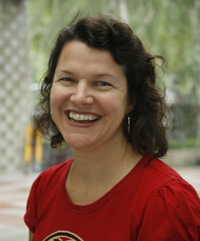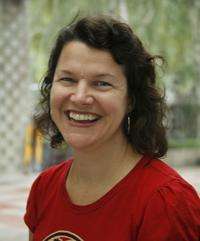Part 2 of a journal by an MSF water and sanitation expert

Kathy Dedieu, MSF Water and Sanitation Specialist
Kathy Dedieu is working as a water and sanitation specialist in the Doctors Without Borders/Médecins Sans Frontières (MSF) emergency project in Bangladesh following Cyclone Aila. The disaster contaminated many water sources, and ongoing flooding during high tides makes it difficult to clean and repair them. It’s Dedieu’s job to come up with alternative ways to get safe drinking water.
July 9: Shrimp farmers by night, construction workers by day
Today I went to the third, and final, place where we are doing medical clinics, in the area of Dakshin Bedkashi. We have nine mobile clinics in total in the affected area, as well as several outreach teams. In Dakshin Bedkashi, you really have to watch out for high tide, because you can only pass through certain places at low tide. Otherwise, where the pathway is broken, you have to go up to your chest through water with strong currents. Again, I make my way, sometimes on a path, sometimes through shallow water, and sometimes in a boat going through what used to be a path or a shallow shrimp pond.
The medical clinic here takes place in one of the few remaining solid structures, which used to be a shrimp market shop. The owner is kindly letting us use it as a medical clinic twice a week. We can arrive by walking there, but by the time we leave, the pathway is full of water up to our knees. The patients mainly have diarrhea and skin rashes from the dirty standing water that is still everywhere. The people in this area had household latrines, but many were washed away. The rest are now flooded. This is an area where I am trying to help; MSF will build the community some new latrines. The big question is “where do you build a latrine when the tide covers the village in 1.25 meters (four feet) of water every day?” When I take a GPS reading, the elevation is often up to two meters (six feet)!
The people here are for the most part shrimp farmers and trappers. They work all night fishing and catching shrimp so the catch is fresh for the ice trucks that are waiting at the dock. Usually, they sleep during the day, but now they are working all day as well, trying to fix the levees during low tide. They make a superstructure of bamboo, which they use like reinforced steel, and then they fill it with their “concrete”, which for them is the ubiquitous clay mud. They dig and place the heavy, thick mud by hand. It is really hard work.
The team doctor, who is originally from the Chittagong Hills area of Bangladesh, put the situation of these people eloquently: “They weren’t rich, and they weren’t poor. They were just living somewhere in the middle. They had nice villages and a nice life; they just never, ever expected this to happen.”
On the boat ride home, we make a stop to see if the bridge to the water pump is completed. I’m happy to see it is, and people are already making good use of it. The ladies of the village are very happy–so, at least one success!
July 12: Raising above high tide
In Chanipur, Padma Pukur, there are families living on the embankment. In order to get their water, they either have to trudge through 1.5 meters (about four feet) of water at high tide—and there is still water on the path in low tide as well—or find a small boat. MSF will improve the access by building a simple bridge. MSF will also chlorinate the pumps and raise them above the high tide. Raising them above the high tide prevents the wells from being recontaminated with every high tide, as they are now.
Today, the team took a small boat down a canal, and saw many destroyed homes along the way. Others are living in isolated situations. They live on their clay mounds with their homes either in ruins or still standing. However, the walkways that connect their homes to the rest of the village have been washed away, so they walk through the tide or take small boats where they used to walk. We go past the primary school, still under one meter (three feet) of water every high tide–so still no school for the children six weeks after the storm.
July 13: Waiting for the rains
Today I went to a village on the mainland called West Durgabati. Here, the embankment has been rebuilt to the degree that the tide does not come in every day anymore, but it is not to the level that it would protect against a strong storm. The people here only use rainwater for their drinking water, which they collect in large artificial ponds. The water is then passed through a sand filter for treatment. The pond water was ruined when the seawater came in. Since the embankment has been repaired, the ponds filled with seawater have been pumped out. Also, the community has improved the sides of the ponds so that the embankments are above the high tide. If the main levee breaks again, the drinking water will not be ruined.
The problem here is that the monsoon rains have not come yet–they are late. The population here is relying on water-trucking provided by several NGOs. To get to these tanks of water, they have to walk up to two kilometers (one-and-a-half miles). They are hoping for the rains! Here, MSF is keeping close surveillance on the water-trucking and the amount of diarrhea cases coming to the clinic. MSF will provide water-trucking if or when it is needed to supplement the existing amounts provided. We are monitoring the quality of this water, as well. We will also start some hygiene promotion to encourage women to use only the water from the water-trucking for drinking, instead of using unsanitary sources while they wait for the rain to come.
July 15: Testing the waters
The people in the area of Burigoalini rely solely on rainwater for their drinking water, which they collect in large man-made, clay-lined ponds. These ponds were inundated during the tidal surge with Cyclone Aila. They have now been pumped empty of their salty water and are awaiting the monsoon rains. They are waiting. And waiting. The monsoons haven’t really come yet, although they usually arrive mid- to late-June. So, the people in this area are still relying on water-trucking for their drinking water, which is provided by local NGOs.
Since MSF has three medical clinics in this area, today my job was to collect samples of the trucked-in water to make sure that it is safe to drink. In particular, I am looking for the presence of E. coli, bacteria that signals the water is contaminated. I took six different samples, and used a field lab for water testing called a DelAgua Kit. I can also test for turbidity with this kit. The turbidity is fine in the water samples, but I have to wait 16 hours to see if there is E. coli. I have to incubate the samples in a growth medium that lets me see if there are bacteria with the naked eye. We’ll know more tomorrow!




